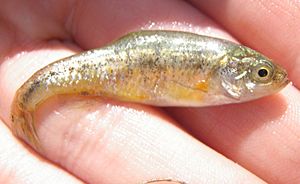Least chub facts for kids
Quick facts for kids Least chub |
|
|---|---|
 |
|
| Conservation status | |
| Scientific classification | |
| Genus: |
Iotichthys
|
| Species: |
phlegethontis
|
| Synonyms | |
|
|
The least chub (Iotichthys phlegethontis) is a tiny ray-finned fish. It belongs to the Cyprinidae family, which includes minnows and carps. This fish is the only species in its group, called the genus Iotichthys.
Contents
Where the Least Chub Lives
This special fish is found only in the state of Utah in the United States. Long ago, it lived in many places around the Great Salt Lake, Utah Lake, and Sevier Lake. You could find it in ponds, swamps, springs, and small rivers. It was also common in springs within the Snake and Utah valleys.
Today, the least chub lives in only a few spring areas. This is because its home has been damaged. Also, other fish that are not native to Utah have been brought in.
What the Least Chub Looks Like and Eats
The least chub is a very small minnow. It grows to be less than 2.5 inches long. This makes it the smallest of the seven types of chubs that live in Utah. Least chubs mostly eat tiny plants called algae. They also eat small bugs, like mosquito larvae.
Life Cycle and Behavior
Least chubs lay their eggs in the spring and early summer. The eggs are fertilized in the water. Then, they sink and stick to plants or the bottom of the water. The parent fish do not take care of their eggs or young. The least chub likes to swim in groups. They prefer areas with lots of plants where the water moves slowly.
Why the Least Chub is in Trouble
The number of least chubs dropped a lot in the 1940s and 1950s. People didn't notice this big drop until the 1970s. There are several reasons why their numbers went down.
One reason is that their homes were damaged. For example, cows grazing near streams can hurt the plants and soil. Water being taken away for other uses also harms their habitat. Building and mining activities can also cause problems.
Another big reason is the introduction of non-native fish. Studies show that when fish like largemouth bass, trout, and mosquitofish are brought in, very few least chubs remain. These non-native fish can eat the least chubs or compete with them for food.
Helping the Least Chub
Even though the least chub still lives in only a few places, people are working to help it. The Utah Division of Wildlife Resources and other groups are putting the fish back into good habitats. Often, they remove the non-native fish first.
Other efforts include working with ranchers. They help ranchers put fences around important spring areas. This stops cattle from damaging the plants and water where the least chub lives.
Least Chub as a Mosquito Fighter
Recently, the Utah Division of Wildlife Resources started a new project. They teamed up with groups that control mosquitoes in Davis and Salt Lake counties. They gave least chubs to people with 240 backyard ponds. The goal is to see if the least chub can replace the mosquitofish. Mosquitofish are often used to control mosquitoes but can be aggressive.
Researchers will watch how well the least chubs do. They want to see if the chubs can control mosquito larvae as well as mosquitofish. They will also check if more chubs are needed to do the same job.
- Muck, J. 1999. Endangered Species Bulletin September/October 1999. [1] Downloaded 3, June 2008.
- Dougherty, Joseph M. 2008. "Least-likely aquatic champion to take on top mosquito-eater" Deseret News Feb 3, 2008. Downloaded 3 June 2008.
See also
 In Spanish: Iotichthys phlegethontis para niños
In Spanish: Iotichthys phlegethontis para niños


